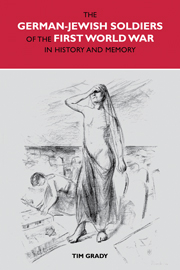Book contents
- Frontmatter
- Contents
- Acknowledgements
- List of Abbreviations
- Introduction
- 1 Dying: War, Mutilation and Mass Death, 1914–18
- 2 Mourning: Defeat, Revolution and Memorialisation, 1918–23
- 3 Commemorating: War Veterans, Ritual and Remembrance, 1923–29
- 4 Forgetting: Nazism, Front Fighters and Destruction, 1929–45
- 5 Discovering: War Victims, War Crimes and Reconstruction, 1945–60
- 6 Embracing: The Growth of Holocaust Awareness and Acknowledgement of the Jewish Soldiers, 1960–80
- Conclusion
- Bibliography
- Index
2 - Mourning: Defeat, Revolution and Memorialisation, 1918–23
- Frontmatter
- Contents
- Acknowledgements
- List of Abbreviations
- Introduction
- 1 Dying: War, Mutilation and Mass Death, 1914–18
- 2 Mourning: Defeat, Revolution and Memorialisation, 1918–23
- 3 Commemorating: War Veterans, Ritual and Remembrance, 1923–29
- 4 Forgetting: Nazism, Front Fighters and Destruction, 1929–45
- 5 Discovering: War Victims, War Crimes and Reconstruction, 1945–60
- 6 Embracing: The Growth of Holocaust Awareness and Acknowledgement of the Jewish Soldiers, 1960–80
- Conclusion
- Bibliography
- Index
Summary
On 11 November 1918, Germany and the Allies signed an armistice treaty that finally brought more than four years of brutal fighting to an end. By this stage in the conflict, the German delegation had little option but to accept the Allies' terms, even though they placed severe restrictions on the country. On the front line, the physical and mental exhaustion of the troops, food shortages and a growing disgruntlement with the conflict had sapped the fighting potential of the German army. The picture was just as bad on the home front, where major strikes throughout 1918 had hinted at the revolutionary potential within Germany. In the days before the armistice, this widespread discontent amongst both civilians and the military led to street protests and, ultimately, to revolution. On 9 November, the Kaiser was forced to abdicate and the republic was declared. The cessation of hostilities and the collapse of Imperial Germany, however, did little to improve conditions within the country. Food and basic supplies remained scarce, while revolutionary violence wreaked havoc in the larger cities. The end of the war also brought little relief to Germany's Jewish population. Not only did the Jews suffer continued material hardships, but many Germans also blamed them for defeat and revolution.
Yet, post-war Germany was not solely dominated by violence, political turmoil and deprivation. With almost two million soldiers killed and just under five million wounded, this was also a time of massive adjustment as large numbers of Germans continued their struggle to come to terms with the effects of the war.
- Type
- Chapter
- Information
- Publisher: Liverpool University PressPrint publication year: 2011



